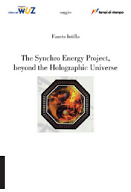
An elevation plot of the highest energy neutron flux distributions from an axial slice of the reactor is shown superimposed over the same slice of the underlying geometry. This figure shows the rapid spatial variation in the high energy neutron distribution between within each plate along with the more slowly varying, global distribution. The figure is significant since UNIC allows researchers to capture both of these effects simultaneously. (Credit: Image courtesy of Argonne National Laboratory)
Source: ScienceDaily
------------------------
ScienceDaily (Jan. 25, 2010) — Ever wanted to see a nuclear reactor core in action? A new computer algorithm developed by researchers at the U.S. Department of Energy's (DOE) Argonne National Laboratory allows scientists to view nuclear fission in much finer detail than ever before.
A team of nuclear engineers and computer scientists at Argonne National Laboratory are developing the neutron transport code UNIC, which enables researchers for the first time to obtain a highly detailed description of a nuclear reactor core.
The code could prove crucial in the development of nuclear reactors that are safe, affordable and environmentally friendly. To model the complex geometry of a reactor core requires billions of spatial elements, hundreds of angles and thousands of energy groups -- all of which lead to problem sizes with quadrillions of possible solutions.
Such calculations exhaust computer memory of the largest machines, and therefore reactor modeling codes typically rely on various approximations. But approximations limit the predictive capability of computer simulations and leave considerable uncertainty in crucial reactor design and operational parameters.
"The UNIC code is intended to reduce the uncertainties and biases in reactor design calculations by progressively replacing existing multilevel averaging techniques with more direct solution methods based on explicit reactor geometries," said Andrew Siegel, a computational scientist at Argonne and leader of Argonne's reactor simulation group.
UNIC has run successfully at DOE leadership computing facilities, home to some of the world's fastest supercomputers, including the energy-efficient IBM Blue Gene/P at Argonne and the Cray XT5 at Oak Ridge National Laboratory. Although still under development, the code has already produced new scientific results.
In particular, the Argonne team has carried out highly detailed simulations of the Zero Power Reactor experiments on up to 163,840 processor cores of the Blue Gene/P and 222,912 processor cores of the Cray XT5, as well as on 294,912 processor cores of a Blue Gene/P at the Jülich Supercomputing Center in Germany. With UNIC, the researchers have successfully represented the details of the full reactor geometry for the first time and have been able to compare the results directly with the experimental data.
Argonne's UNIC code provides a powerful new tool for designers of safe, environmentally friendly nuclear reactors -- a key component of our nation's current and future energy needs. By integrating innovative design features with state-of-the-art numerical solvers, UNIC allows researchers not only to better understand the behavior of existing reactor systems but also to predict the behavior of many of the newly proposed systems having untested design characteristics.
Development of the UNIC code is funded principally by DOE's Office of Nuclear Energy through the Nuclear Energy Advanced Modeling and Simulation (NEAMS) program. The Argonne UNIC project is a key part of the NEAMS efforts to replace the traditional "test-based" approach to nuclear systems design with a new "science-based" approach in which advanced modeling and simulation play a dominant role.
The code could prove crucial in the development of nuclear reactors that are safe, affordable and environmentally friendly. To model the complex geometry of a reactor core requires billions of spatial elements, hundreds of angles and thousands of energy groups -- all of which lead to problem sizes with quadrillions of possible solutions.
Such calculations exhaust computer memory of the largest machines, and therefore reactor modeling codes typically rely on various approximations. But approximations limit the predictive capability of computer simulations and leave considerable uncertainty in crucial reactor design and operational parameters.
"The UNIC code is intended to reduce the uncertainties and biases in reactor design calculations by progressively replacing existing multilevel averaging techniques with more direct solution methods based on explicit reactor geometries," said Andrew Siegel, a computational scientist at Argonne and leader of Argonne's reactor simulation group.
UNIC has run successfully at DOE leadership computing facilities, home to some of the world's fastest supercomputers, including the energy-efficient IBM Blue Gene/P at Argonne and the Cray XT5 at Oak Ridge National Laboratory. Although still under development, the code has already produced new scientific results.
In particular, the Argonne team has carried out highly detailed simulations of the Zero Power Reactor experiments on up to 163,840 processor cores of the Blue Gene/P and 222,912 processor cores of the Cray XT5, as well as on 294,912 processor cores of a Blue Gene/P at the Jülich Supercomputing Center in Germany. With UNIC, the researchers have successfully represented the details of the full reactor geometry for the first time and have been able to compare the results directly with the experimental data.
Argonne's UNIC code provides a powerful new tool for designers of safe, environmentally friendly nuclear reactors -- a key component of our nation's current and future energy needs. By integrating innovative design features with state-of-the-art numerical solvers, UNIC allows researchers not only to better understand the behavior of existing reactor systems but also to predict the behavior of many of the newly proposed systems having untested design characteristics.
Development of the UNIC code is funded principally by DOE's Office of Nuclear Energy through the Nuclear Energy Advanced Modeling and Simulation (NEAMS) program. The Argonne UNIC project is a key part of the NEAMS efforts to replace the traditional "test-based" approach to nuclear systems design with a new "science-based" approach in which advanced modeling and simulation play a dominant role.
Story Source:
Adapted from materials provided by DOE/Argonne National Laboratory.
Adapted from materials provided by DOE/Argonne National Laboratory.


























